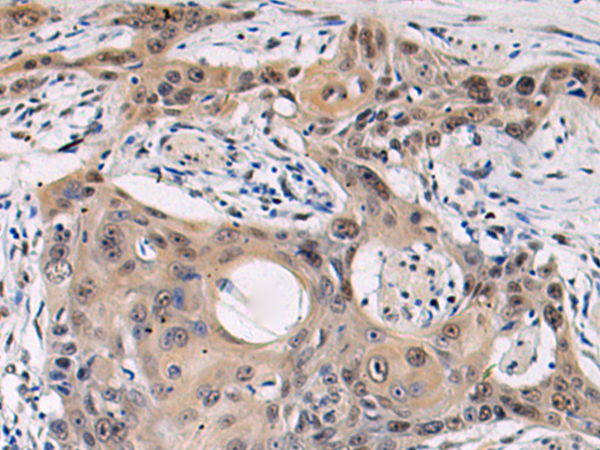
| WB | 咨询技术 | Human,Mouse,Rat |
| IF | 咨询技术 | Human,Mouse,Rat |
| IHC | 1/25-1/50 | Human,Mouse,Rat |
| ICC | 技术咨询 | Human,Mouse,Rat |
| FCM | 咨询技术 | Human,Mouse,Rat |
| Elisa | 1/5000-1/10000 | Human,Mouse,Rat |
| Aliases | mER; CEPR; GPER; DRY12; FEG-1; GPR30; LERGU; LyGPR; CMKRL2; LERGU2; GPCR-Br |
| Host/Isotype | Rabbit IgG |
| Antibody Type | Primary antibody |
| Storage | Store at 4°C short term. Aliquot and store at -20°C long term. Avoid freeze/thaw cycles. |
| Species Reactivity | Human, Mouse, Rat |
| Immunogen | Synthetic peptide of human GPER1 |
| Formulation | Purified antibody in PBS with 0.05% sodium azide and 50% glycerol. |
+ +
以下是关于GPER1抗体的3篇关键参考文献,简要整理如下:
---
1. **文献名称**:*Estrogen action via the G protein-coupled receptor GPR30*
**作者**:Filardo EJ, et al.
**摘要**:该研究首次提出GPR30(后命名GPER1)作为新型雌激素膜受体,介导非基因组信号通路。通过特异性抗体检测,发现其在乳腺癌细胞中激活下游信号分子(如cAMP),揭示了其独立于经典核受体的功能。
2. **文献名称**:*A transmembrane intracellular estrogen receptor mediates rapid cell signaling*
**作者**:Revankar CM, et al.
**摘要**:研究利用GPER1特异性抗体进行亚细胞定位,证实其在细胞膜和高尔基体的表达。实验表明GPER1通过激活MAPK/ERK通路介导雌激素的快速信号转导,抗体阻断实验进一步验证了其功能。
3. **文献名称**:*GPR30 expression is required for the mineralocorticoid receptor-independent rapid vascular effects of progesterone*
**作者**:Thomas P, et al.
**摘要**:通过免疫组化和Western blot分析,研究显示GPER1抗体在血管内皮细胞中特异性标记受体,并揭示其在孕激素介导的血管舒张中的作用,强调了GPER1在非经典激素通路中的重要性。
---
这些文献均通过抗体技术验证了GPER1的定位、表达及功能,为后续研究提供了方法学参考。如需具体年份或期刊,建议通过PubMed/Google Scholar按标题检索。
GPER1 (G protein-coupled estrogen receptor 1), formerly known as GPR30. is a membrane-associated estrogen receptor that mediates rapid, non-genomic signaling pathways distinct from classical nuclear estrogen receptors (ERα and ERβ). It is involved in various physiological and pathological processes, including cell proliferation, apoptosis, migration, and inflammation, with implications in cancer, cardiovascular diseases, and metabolic disorders. GPER1 antibodies are essential tools for studying its expression, localization, and function in tissues and cell lines. These antibodies are widely used in techniques like Western blotting, immunohistochemistry (IHC), immunofluorescence (IF), and flow cytometry to detect GPER1 protein levels or visualize its subcellular distribution.
Due to historical challenges in antibody specificity, validation is critical. Reliable GPER1 antibodies should demonstrate minimal cross-reactivity with other estrogen receptors and be verified using knockout (KO) cell lines or tissues. Recent research highlights GPER1's role in hormone-sensitive cancers (e.g., breast, ovarian) and neurodegenerative diseases, driving demand for high-quality antibodies. Commercial antibodies often target epitopes within the receptor’s extracellular N-terminus or intracellular C-terminal domains. Ongoing studies explore GPER1 as a therapeutic target, further emphasizing the need for robust detection reagents to advance mechanistic and clinical investigations.
×